You too can enjoy the litter-free life!
Training your cat to use the toilet is becoming more and more popular. The benefits of having a toilet-trained cat can be well worth the training effort. Can you imagine:
Never buying cat litter again?
Never cleaning a litter box?
No grit on the floor?
No smell?
There are even more advantages of kitty potty training. As you train your cat, you will become more aware of your cat's personality and health. Successful potty trainers really get inside their cat's head; they are able to see things from a feline point of view. And, by keeping such a close eye on kitty's elimination, you can catch health issues like feline urinary tract infection early on.
Rules of the road
As I mention in my video "Kitty Potty Training" (see embedded video below), the key ingredients to toilet training are patience, perseverance, and plenty of positive reinforcement. Enlist other family members in your project, as you will need to rely on their patience, too! There are various commercial and homespun methods of toilet training, and using the clicker from the start makes each method easier.
The most important principle to remember is: Go slow. Most adult cats hate change, so you must introduce any changes in their routine very slowly. You are basically shaping a whole series of behaviors to get your cat to transition from using a litter box on the floor, to jumping up onto the toilet, to eliminating in a raised bowl filled with water—the toilet bowl. You can train kittens, too, but make sure they are old enough to extricate themselves from the toilet bowl should they fall in.
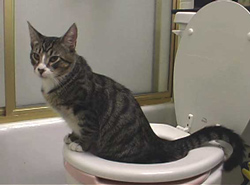
Training gets easier the more you keep at it, but problems do occur. Any time you get stuck or your kitty regresses to unwanted behavior, it is probably your fault. Most likely you proceeded with the steps too fast, you asked too much of the cat too soon, or you failed to get the cat to associate each step of the training with a positive reward.
The better rapport you have with your cat, the smoother your training will be. A great way to build rapport with your cat is clicker training. Some say that cats can't be trained, but we know that cats understand the training process quite well. In fact, your cat has probably already trained YOU, without you even knowing it. She has trained you to open the door when she meows, to pet her when she jumps in your lap, to feed her when she joins you in the kitchen. Toilet training is really just convincing your kitty that SHE'S training YOU to reward her for perfectly natural behaviors.
Laying the groundwork
First train your cat in targeting. Review targeting articles or books if you need a refresher. Once you have trained her to touch the target, train her to jump up where you want her to go. Practice with chairs and footstools, with the toilet with the lid closed, and, finally, with the toilet with the lid open, seat down. Always praise and treat consistently.
Next, train your cat to acclimate to a toilet seat. Buy an inexpensive toilet seat at any hardware store. Spend some time every day playing with your cat in and around the toilet seat on the floor. Let your cat get used to stepping on it and feeling it under her feet—even sleeping in it. Click and treat often when you play there. If the seat on your bathroom toilet is padded, you should use a padded one for the acclimatization process, too.
Meanwhile, if your cat's litter box is not already in the bathroom, you need to move it there. Assume that every change is a potential obstacle for your cat and proceed in small, daily increments until the litter box is in the bathroom next to or very near the toilet. If you are lucky enough to have more than one bathroom, pick one for training—preferably the one used less frequently by you or family members.
If your cat accepts it, you can move the litter box to a new location all at once. Some cats will go wherever there is litter. Other cats will resist the change and continue to go in the spot where the litter box used to be. Again, click and treat whenever your cat uses the litter box in its new location. Create a positive association between the bathroom and your cat.
First setup
Once the litter box is in the bathroom, you are ready to proceed to the first setup. Use sturdy mailing tape to tape your spare toilet seat on top of a litter box. Make sure this setup is rock solid, because most cats hate uneven surfaces. You don't want the setup to tip over when the cat steps onto it.
Use target training to get your cat to step on and around the first setup, even if the cat doesn't have to go potty at the moment. Your goal is to make the setup a nice, rewarding place to be. Play with her there. Dangle a string or fishing-type toy above and around the setup. Let her get used to stepping on the toilet seat and feeling it hold her weight.
With this kind of encouragement, most cats will continue to use the litter box even after you've taped the toilet seat to it. After a week of going in this toilet seat-shaped litter box, your cat is ready to transition to the second setup, a litter box in the toilet.
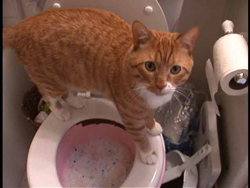
Second setup
Some cats will resist jumping up onto the toilet seat in order to use the litter box. If your cat has had consistent positive reinforcement for jumping onto the toilet seat, this shouldn't be a problem. However, especially for older cats or young kittens, you can shape the move from floor to toilet by raising the first setup in small increments. You can use a step stool, or make steps out of weighted cardboard boxes. Over the course of a week or two, gradually raise the first setup until it is level with the toilet. Always click and treat for any new change in the routine.
There are various ways of constructing a "litter box in the toilet." Some people use a commercial product; others create a homemade litter box out of a plastic mixing bowl, roasting pan, or sitz bath. I prefer the sitz bath method. A sitz bath is a small plastic basin that fits inside the rim of the toilet seat. You can get one online or at most large drug stores. It is both inexpensive and sturdy.
Fill the sitz bath with litter and place it inside the toilet. Ask your cat to jump onto the toilet seat and investigate the situation. Click and treat. Most cats will happily scratch in the litter and may even do a little business there. Praise and click and treat for any of these behaviors. At this point it is a good idea to tape up the lid of the toilet seat so that your cat doesn't accidentally get bonked on the head, which would be a sure-fire way of extinguishing all the great behavior you've been shaping. Leave the lid taped up for the duration of the training. Take away the first setup entirely, and store it somewhere hidden from view in case you need to backtrack.
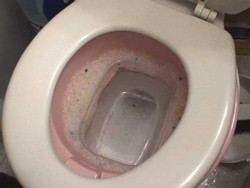
Let the cat use the second setup for a week or so, until she is completely used to it. This is a critical period where you need to keep an eye on kitty. Make sure she has not found an undesirable place to go potty.
Place her on the toilet seat and encourage her to go in the setup several times a day. Good times to practice are after she's eaten or when she's awakened from a nap—just like training a child. Always click and treat for jumping up onto the toilet seat, for scratching, and for squatting.
Often, cats will jump up and scratch around in the setup, and then jump down again and give you a confused "meow?" Pick up your car and place her back on the setup. Click and treat. You may have to repeat this process several times. Let the clicker speak for you; you don't have to talk. Be patient, silent, and observant, and reward your cat for any behavior that indicates progress toward eliminating in the setup.
Moving forward
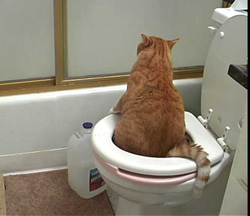
Once your cat used the sitz bath litter box successfully, you are ready to move on. Start by making a small hole in the sitz bath. You can use a drill or a soldering iron to melt the plastic. Some of the litter will fall through the hole when kitty scratches. That is okay—you want her to get used to the water underneath the setup.
The next week, enlarge the hole slightly. Continue enlarging the hole every week until kitty's waste is dropping directly into the toilet. At the same time, gradually reduce the quantity of litter in the sitz bath to a token amount. Once the hole is so big that there's nothing left, kitty will naturally place her feet on the toilet seat. This whole process can take as little as a month or as long as a year depending on your cat's temperament and how dedicated you are to monitoring and rewarding her behavior.
Maintenance
Unlike some other animals, cats seem to lose interest if not rewarded almost every time they do a task correctly during the active learning phase. Consistent treating is best for this challenging time. Of course, there will be times when you won't be around to treat after kitty uses the toilet, and by default a variable reward schedule occurs. Unpredictable or variable rewards are what make gambling so addictive, and cats are expert gamblers.

Bad habits in cats can be hard to extinguish. For example, if your cat has to relieve herself and finds a nice, clean, dry bathroom sink, it's inherently rewarding to go in the sink. The relief itself is a jackpot. Let a cat get away with eliminating on the floor or sink just once, and she will try to hit that jackpot again. Preventing mistakes is always easier than trying to break a bad habit after it occurs.
The bottom line is: don't gamble with expert gamblers like cats. Put away the bath rugs for the duration of toilet training; pick up the towels and newspapers off the bathroom floor. Keep a small amount of water in the sink or tub. Keep the shower doors shut. Close closet doors, use closed hampers for dirty clothes, or remove laundry baskets from the bathroom. Close off rooms that the cat doesn't need to go into to prevent her from getting into trouble. When in doubt, backtrack!
For additional help and details, watch the short video, "Kitty Potty Training" (embedded above). Your click on the sponsor's ad at the end of the video will donate 25 cents to feed stray cats.
For a wealth of information on toilet training (not necessarily clicker style, however), visit the Yahoo Group Cats T-Training.
And remember: Patience, perseverance, and plenty of clicks and treats!

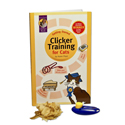
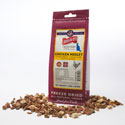
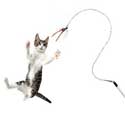
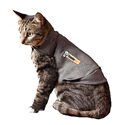


toilet training
What if my cat likes to drink out of the toilet. Is toilet training still an option?
Great tips but two questions:
Great tips but two questions: 1) what can you suggest as a treat for a kitty who turns her nose at up at (packaged) kitty treats? Her brother is a treat hog so he's no problem but she sniffs the treat and just looks at me like "that's nothing I want". I don't know what to have handy that will excite her and reward her. Also, neither one of them seem to like catnip. I've been placing it around their scratching post to encourage visits but it's totally ineffective. 2) Would love to watch the video but there is no "embedded link".
Video Link Fixed
Thanks for the update, the video should now be linked.
cat not using the litter tray
Hi my name is Elena and i come from Cyprus. i am a cat lover even since i remember in my life. and i have cats all these years. the last 8 i have two. noe Persian and one Siamese. Both boys.They live together but they don't play or sleep together. They share food. Some times the Persian ses the litter tray but mostly he loves to pipi and poupou at the entrance of the flat. You can imagine.... and every time i come from work with a customer i pray to God not to embarrassed me again. Pls help me... tell me how to stop it.
insert alternative
I used a potty training seat, a wooden seat that has a smaller one that can go into the lid when no longer needed. I trained my 12 week old kitten and needed it because she was afraid to fall in. Under that seat, I used corrugated plastic in white.. same colour as the bowl and is quite stable if you cut it to fit the outside of the bowl. It's very easy to cut with an exacto knife, and you can make a hole in the middle easily too with the same knife. I took it slowly and in 2 weeks, she was fully toilet trained. When she goes during the day, she comes up to me and lets me know. I tell her to show me, and she will run to the bathroom and wait for me to say "good poop" and the we go to the kitchen and she gets her treat, and her favourite is a few peas.
I will be getting a male Ragdoll soon who has had 2 homes so far (he's just turned 2), returned to the breeder because, after a few weeks, will jump up on furniture and look at you as he relieves himself fully. He has resisted all the different litters, so I think he's a great candidate for the toilet training. I have routines every day, including obedience training, for the dogs and the cat. The dogs I board learn this routine easily and love it. And, IF I can't rehab this cat, his alternative is euthanasia.
If we use elongated
If we use elongated toilets, then we can easily teach pet animals about their behavior in the toilet. These tips might come in handy if you have a loyal pet.
How cute
This has been really helpful i will try it on my cat see it if works ....maybe on my one year old kid..i will try it on a portable toddler potty
Toilet insert alternative
A cheaper and easier to cut alternative to a sitz bath is a disposable, foil roasting pan. I believe this is what she means by "roasting pan" in the alternatives listed. It's easier to cut (utility blade works well), you don't risk creating toxic fumes like melting a hole in a sitz bath and if you have to back up a step because you enlarged the hole too quickly, it's no big deal to have to buy another pan. Make sure you carefully fold under the sharp edges of the hole you make to make sure your cat won't get cut when scratching the litter and be careful not to cut yourself in the process. ;-) I also added a "Flip-N-Flush" child's potty seat (no affiliation, http://www.flipnflush.com/flip.html) so my cat has more area to balance. If you're just using the regular seat and the cat is starting out with their feet in the litter, you may want to nest 2 foil pans for stability.
BTW, this is a great article. I just have a difference preference for materials.
Post new comment